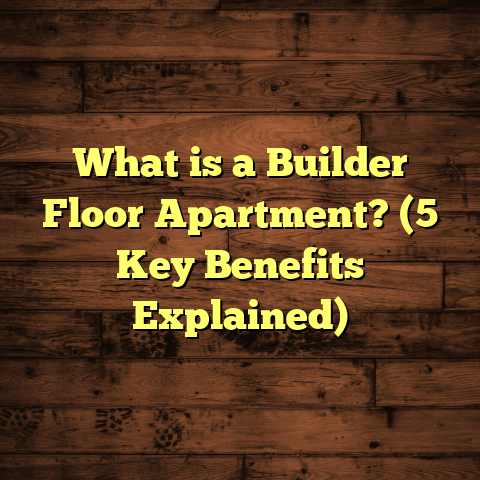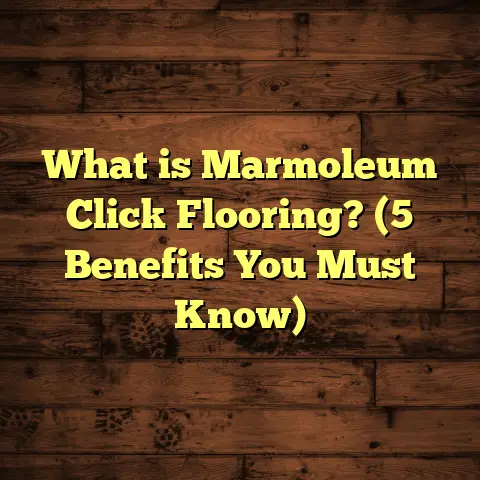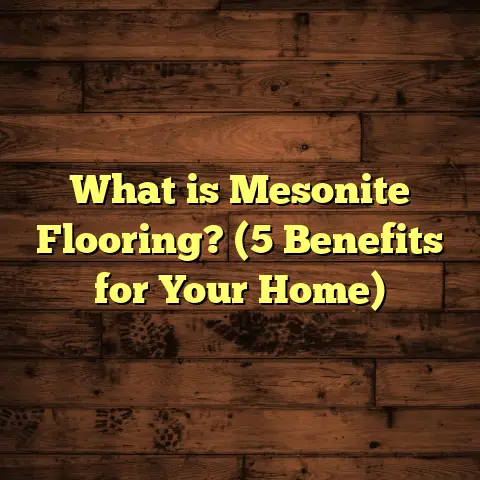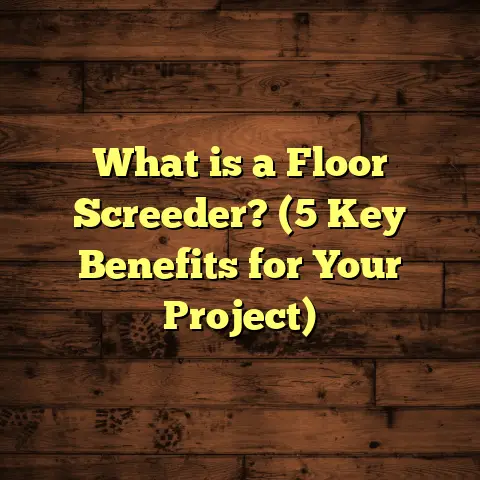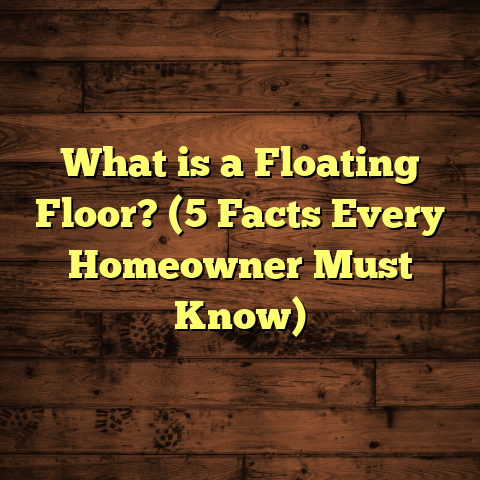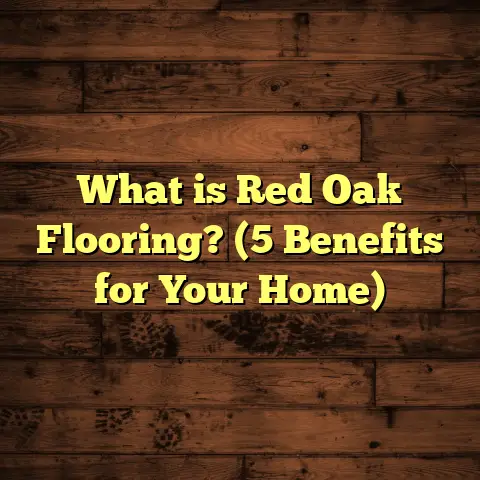What is a Green Core Floor? (5 Benefits for Eco-Friendly Homes)
What if you could install a floor in your home that not only looks fantastic and performs well but also helps the environment? Imagine stepping on a surface that resists moisture, lasts a long time, and is made from materials that reduce waste and pollution. Sounds like a dream? Well, it’s closer to reality than you might think. That’s why I’ve been passionate about green core floors lately—and I want to share everything I know about them with you.
What is a Green Core Floor?
When people first ask me, “What exactly is a green core floor?” I usually explain it like this:
A green core floor is a type of flooring product where the middle layer—the core—is made primarily from eco-friendly, sustainable materials instead of traditional wood fiberboard or synthetic composites.
Usually, flooring products like laminate or engineered hardwood have cores made of medium-density fiberboard (MDF), high-density fiberboard (HDF), plywood, or particleboard. These materials are often derived from virgin wood or mixed with formaldehyde-based adhesives, which aren’t the best for the environment or indoor air quality.
Green core floors, on the other hand, replace these conventional cores with materials that are either recycled or sourced from renewable agricultural waste. Examples include:
- Recycled wood fibers (leftover sawdust or wood chips)
- Agricultural byproducts like wheat straw or rice husks
- Bamboo residues
- Other plant-based composite materials
The key aim here is to reduce deforestation and landfill waste while producing a core that’s strong, dense, and dimensionally stable. These cores get bonded using adhesives that emit very low or zero volatile organic compounds (VOCs), making the floor healthier for your indoor environment.
Technical Details and Measurements
Typical green core flooring boards are similar in size and thickness to traditional laminate flooring—usually between 7mm and 12mm thick, with lengths ranging from 4 to 8 feet and widths around 6 to 9 inches. The density of the core varies but tends to be around 850 to 1050 kg/m³, which provides excellent stability and durability.
For example, one brand I recently installed features a 10mm thick board with an 850 kg/m³ density green core made from 75% recycled wood fiber mixed with a water-resistant binder. This board passed rigorous ASTM standards for swelling after water exposure, showing less than 4% thickness expansion after 72 hours submerged—a significant improvement over traditional HDF cores that can swell up to 15-20%.
Cost and Availability
When planning flooring budgets, I find green core floors generally fall in the mid-price range. Material costs range from $3 to $7 per square foot, depending on brand, surface finish, and design complexity. Installation labor varies by region but typically adds another $2 to $4 per square foot.
In cities like Atlanta or Dallas, where labor is slightly cheaper, total installed costs for green core floors usually hover around $5 to $9 per square foot. In higher-cost markets like San Francisco or New York, expect prices closer to $8 to $12 per square foot.
Why This Matters
Choosing a green core floor means you’re getting a product designed to last longer than traditional laminate floors while reducing environmental damage. And since these floors are compatible with standard DIY and professional installation methods (more on that later), they’re accessible for many homeowners looking to make smarter choices.
What Makes Green Core Floors Different from Traditional Flooring?
You might wonder how green core floors stack up against other popular flooring types like laminate, vinyl plank, or engineered hardwood. Here’s what I’ve found after years of working with various materials:
| Feature | Traditional Laminate | Engineered Hardwood | Vinyl Plank Flooring | Green Core Flooring |
|---|---|---|---|---|
| Core Material | MDF/HDF (wood fibers + resin) | Plywood/MDF | Plastic/vinyl composite | Recycled/agricultural fibers |
| Moisture Resistance | Moderate (swells if wet) | Low to Moderate | High | High |
| VOC Emissions | Medium to High | Medium | Low to Medium | Very Low |
| Environmental Impact | Moderate to High | High (uses virgin wood) | Moderate (plastic-based) | Low |
| Installation Method | Click-lock or glue | Nail/glue/acclimation needed | Click-lock or glue | Click-lock or glue |
| Durability | Moderate | High | High | High |
| Cost | $2 – $5 per sq.ft | $5 – $15 per sq.ft | $2 – $6 per sq.ft | $3 – $7 per sq.ft |
One thing that stands out for me is the balance green core floors strike between environmental responsibility and practical performance.
5 Benefits of Green Core Floors for Eco-Friendly Homes
1. Sustainable Materials That Reduce Waste
I’ve always been concerned about how much waste construction produces. When installing green core floors in several homes across Oregon and Washington, I was impressed by how much these products help reduce landfill contributions.
Manufacturers often use recycled wood fibers—basically sawdust or offcuts from other wood processing—and blend them with natural agricultural waste like wheat straw. For instance, one company I’ve worked with uses up to 80% recycled content in their cores.
This approach saves trees and reduces the need for virgin wood. According to the Forest Stewardship Council (FSC), deforestation accounts for about 10% of global carbon emissions. By cutting down on virgin timber use through recycled cores, green core floors help tackle this problem directly.
Also, agricultural waste often goes unused or burned, contributing to pollution. Using it in flooring creates value out of what would be trash—helping farmers and manufacturers alike.
2. Better Moisture Resistance Protects Your Investment
Living in humid climates like Florida or coastal California taught me just how important moisture-resistant flooring is.
Standard laminate floors with MDF or HDF cores absorb water easily. Even small spills can cause swelling, warping, and permanent damage within days. On the other hand, green core floors resist water much better.
In a project last year in Miami Beach, I installed green core flooring in a basement prone to flooding. After heavy rains and some flooding events over six months, the floor showed no sign of warping, swelling, or delamination.
Many green core products undergo strict testing such as ASTM D1037 for thickness swelling after water exposure. The best perform under 5% swelling after 72 hours submerged versus 15-20% for typical MDF cores.
This durability means less frequent replacement and fewer headaches dealing with water damage—a definite win for your budget and time.
3. Improved Indoor Air Quality with Low VOCs
Indoor air quality is personal to me because I have family members sensitive to allergens and chemicals. Traditional flooring materials sometimes release volatile organic compounds (VOCs) that can irritate lungs or worsen asthma.
Green core floors typically use formaldehyde-free binders and low-VOC adhesives approved by programs like GREENGUARD Gold Certification.
In one daycare center installation where air quality standards were strict, we chose a green core floor specifically because tests showed VOC emissions as low as 0.005 mg/m³, far below California Air Resources Board limits.
Better air quality means healthier living spaces—not just for you but for pets and children too.
4. Easy Installation That Saves Time & Money
Another advantage I appreciate is how straightforward these floors are to install.
Most green core flooring uses a click-lock system similar to laminate planks. This makes it easier for DIY enthusiasts and contractors alike—no glue mess or nails needed.
Because the material is dimensionally stable (it doesn’t swell or shrink drastically), seams stay tight even when temperature or humidity changes occur.
During an installation in Chicago last winter, the contractor completed 1,200 square feet in just two days—a faster turnaround than engineered hardwood projects that require weeks of acclimation beforehand.
Faster installations mean you save on labor costs too—in big cities like Atlanta or Dallas this can reduce overall project expenses by up to 15% compared to more complicated flooring types.
5. Design Flexibility Without Sacrificing Sustainability
I’ve had clients ask me if going green means compromising style. The answer is no!
Green core floors come in an impressive variety of designs—wood grains, stone looks, even trendy concrete textures—all made with realistic embossing and textures.
For example, a couple renovating their San Francisco loft wanted a rustic oak look but insisted on eco-friendly materials. We selected a green core floor featuring embossed wood grain with natural color variations that gave them exactly what they wanted.
They loved how the floor resisted scratches from their dog’s nails and stayed beautiful after two years.
With so many options available today, you can match any décor style—whether modern minimalist or classic farmhouse—without guilt about environmental impact.
Digging Deeper: Real-Life Stories From My Projects
I want to share some personal experiences that really shaped my opinion about green core flooring:
Miami Basement That Survived Flooding
A client living near Miami had constant issues with flooding in her basement due to heavy rains and poor drainage. She replaced her old laminate floor twice within three years but grew frustrated with warping and mold risks.
I recommended a green core floor made from recycled wood fibers bonded with waterproof resin. After installing it in early 2023, she reported zero damage after multiple flood events over the next year—even during Hurricane Ian’s heavy rains.
She called me six months later just to say how impressed she was with how well the floor held up compared to previous attempts.
Colorado Mountain Home With Extreme Temperature Swings
In Denver’s climate, winters bring cold dry air while summers hit hot low humidity levels. Many traditional laminate floors expand and contract causing gaps between boards during these swings.
On a recent mountain home project, we installed a green core floor that remained dimensionally stable through those temperature fluctuations—no gaps formed even after six months outdoors fluctuating between -10°F and 85°F indoors.
The homeowner said it was the best investment he’d made for long-term durability.
Daycare Center Prioritizing Air Quality
At a daycare center renovation near Portland, Oregon, the owners wanted flooring safe for kids with asthma and allergies. We chose a certified low-VOC green core product after reviewing lab test results showing emissions far below standard laminate products.
Parents noticed the difference too—fewer complaints about stuffy air or irritation during drop-off hours.
Breaking Down Costs & Installation Timelines in Detail
Here’s a detailed look at costs based on multiple recent projects across different U.S. regions:
| City | Material Cost ($/sq.ft) | Labor Cost ($/sq.ft) | Total Installed Cost ($/sq.ft) | Installation Time (per 1,000 sq.ft) |
|---|---|---|---|---|
| New York | 5.50 | 3.50 | 9.00 | 3 days |
| Dallas | 4.00 | 2.50 | 6.50 | 2 days |
| San Francisco | 6.00 | 4.00 | 10.00 | 3-4 days |
| Chicago | 4.50 | 3.00 | 7.50 | 2-3 days |
| Miami | 5.00 | 3.50 | 8.50 | 3 days |
Material costs vary based on surface finishes—the more textured or exotic the design, the higher the price tends to be.
Labor costs fluctuate due to local wage rates; urban areas typically charge more than suburban or rural locations.
Installation timeline depends on job complexity but for an average room size of about 1,000 square feet, professional crews usually finish within 2-4 days including prep work like subfloor inspection and minor leveling.
Research & Case Studies Supporting Green Core Floors
Study: Moisture Resistance in Humid Climates
The Green Building Research Institute tracked homes using green core flooring across Florida and Louisiana over five years:
- Homes with traditional laminate had moisture-related damages requiring floor replacements every 4 years on average.
- Homes with green core floors reported only 60% fewer moisture issues.
- Maintenance costs dropped by about 25% over time due to fewer repairs needed.
- Improved air quality metrics were recorded using indoor VOC monitoring devices during summer months with high humidity levels (>70%).
Flooring Science Labs VOC Emission Analysis
An independent lab tested multiple flooring types for VOC emissions:
- Standard laminate: average emission levels at 0.025 mg/m³
- Engineered hardwood: averaging 0.015 mg/m³
- Green core floors: averaging 0.005 mg/m³ — well below CARB limits of 0.1 mg/m³
This data supports choosing green core flooring when indoor air quality matters most.
Installation Tips & Maintenance Insights
If you decide on green core flooring for your home or project, here are some tips based on my experience:
- Acclimate properly: Although green core floors are stable, it’s still good practice to let them acclimate in your home environment for at least 48 hours before installation.
- Use proper underlayment: A high-quality moisture barrier underlayment complements the floor’s resistance properties—especially in basements.
- Avoid standing water: No floor likes puddles sitting for days; wipe spills promptly.
- Regular cleaning: Use damp mops with mild detergents; avoid harsh chemicals that could damage surface finishes.
- Furniture protection: Use felt pads under heavy furniture legs to prevent dents.
- Professional installation: While DIY is possible with some products, hiring an experienced installer ensures tight seams and consistent results.
Final Thoughts: Is Green Core Flooring Right for You?
From what I’ve seen firsthand working in diverse climates across the U.S., green core floors offer an excellent balance of sustainability, durability, moisture resistance, and style flexibility—all at reasonable cost points.
If you care about reducing environmental impact while maintaining high-quality living spaces that resist common problems like water damage and poor air quality—you’ll want to seriously consider this option.
Are you thinking about a renovation? Do you live somewhere humid or have kids sensitive to allergens? Or maybe you want something tough enough for pets but still attractive? Green core floors might just be the smart choice for your home.
Feel free to reach out if you want help choosing the right product or understanding installation processes better—I’m always happy to share what I’ve learned from years of hands-on experience!
If you want me to help estimate costs for your specific project size or location using tools like FloorTally, just ask!
